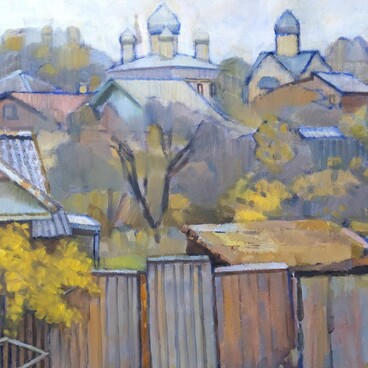The Volkhov River, which begins its flow two versts (about 2 km) from Veliky Novgorod, has long divided the city into eastern and western sides, and it is not a simple geographical division. On the left, western bank, or the Sophia Side, the St. Sophia Cathedral and the Kremlin, surrounded by a fortress wall with towers and gates, were erected. It housed the residences of Archbishop of Novgorod and the prince and his retinue. The side consisted of three districts, or “ends”.
The right, eastern side was named the Trade Side for the shops that began at the very bank. Each trade row had its own name, for instance, the Icon, Sheepskin, Caftan, and Soap ones. Merchants were allocated a place for their shop depending on the product offered. In the 16th century, this lively part of the city included about 1,800 barns, shops and similar buildings.
The southern side of the Trade Mart was adjacent to Yaroslav’s Court: in the 11th century, a wooden palace of Prince Yaroslav was erected there, which has not survived to this day.
Between the Saint Nicholas Cathedral and the Church of Paraskeva Friday there was a belfry, in front of which the elected city veche (assembly) gathered.
The yards of foreign merchants from other Russian and European cities were located behind the Trade Mart. Among them were Pskov and Tver, German and Gotsky yards (named after the island of Gotland).
Merchant ships coming from abroad usually made a stop at the mouth of the Neva River at Kotlin Island. From there, Novgorod bailiffs escorted them to the very Novgorod wharves, supplied them with ship pilots, and protected them from dangers on the way.
At various times, many churches were built on the Trade Side, the construction of which was usually paid for by merchants (including foreigners) or “street people” — residents of the surrounding streets.
In 1127–1130, by decree of Prince Vsevolod Mstislavich, the Church of John the Baptist was built on the Trade Side “in memory of his family”. The wax merchants (who were in wax trade), having received this church at their disposal, used it not only for divine services. Its maintenance rooms from time to time became a place for feasts and bratchinas (traditional banquets); deals were negotiated and disputes were settled. The only standard balance and scales for weighing wax in the city were stored there as well.
In 1453, the dilapidated church of John the Baptist, by order of Archbishop Evfimy of Novgorod, was dismantled and replaced with a new one, similar in design. The new church was destroyed in the Great Patriotic War, but was restored again.
The right, eastern side was named the Trade Side for the shops that began at the very bank. Each trade row had its own name, for instance, the Icon, Sheepskin, Caftan, and Soap ones. Merchants were allocated a place for their shop depending on the product offered. In the 16th century, this lively part of the city included about 1,800 barns, shops and similar buildings.
The southern side of the Trade Mart was adjacent to Yaroslav’s Court: in the 11th century, a wooden palace of Prince Yaroslav was erected there, which has not survived to this day.
Between the Saint Nicholas Cathedral and the Church of Paraskeva Friday there was a belfry, in front of which the elected city veche (assembly) gathered.
The yards of foreign merchants from other Russian and European cities were located behind the Trade Mart. Among them were Pskov and Tver, German and Gotsky yards (named after the island of Gotland).
Merchant ships coming from abroad usually made a stop at the mouth of the Neva River at Kotlin Island. From there, Novgorod bailiffs escorted them to the very Novgorod wharves, supplied them with ship pilots, and protected them from dangers on the way.
At various times, many churches were built on the Trade Side, the construction of which was usually paid for by merchants (including foreigners) or “street people” — residents of the surrounding streets.
In 1127–1130, by decree of Prince Vsevolod Mstislavich, the Church of John the Baptist was built on the Trade Side “in memory of his family”. The wax merchants (who were in wax trade), having received this church at their disposal, used it not only for divine services. Its maintenance rooms from time to time became a place for feasts and bratchinas (traditional banquets); deals were negotiated and disputes were settled. The only standard balance and scales for weighing wax in the city were stored there as well.
In 1453, the dilapidated church of John the Baptist, by order of Archbishop Evfimy of Novgorod, was dismantled and replaced with a new one, similar in design. The new church was destroyed in the Great Patriotic War, but was restored again.




